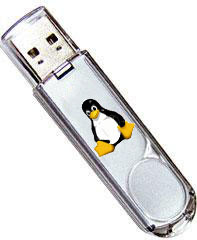 The following steps configure a USB pen drive as a boot medium to start the installation of Red Hat Enterprise Linux.
The following steps configure a USB pen drive as a boot medium to start the installation of Red Hat Enterprise Linux.- Attach the USB pen drive to a system which is already running Red Hat Enterprise Linux.
- Run
- From the dmesg output, identify the device name under which the drive is known to the system.
Sample messages for a 1 Gb flash disk being recognized as /dev/sdb: - Note: For the remainder of this article, we will assume this device name to be /dev/sdb. Make sure you adjust the device references in the following steps as per your local situation.
- At this point, the flash drive is likely to have been automatically mounted by the system. Make sure the flash drive is unmounted. E.g. in nautilus, by right-clicking on the icon for the drive and selecting Unmount Volume.
- Use fdisk to partition the flash drive as follows:
- There is a single partition.
- This partition is numbered as 1.
- Its partition type is set to 'b' (W95 FAT32).
- It is tagged as bootable.
- Format the partition created in the previous step as FAT:
- Mount the partition:
- Copy the contents of /RedHat/isolinux/ from the first installation CD/DVD onto the flash drive, i.e. to /mnt.
Note: the files isolinux.bin, boot.cat and TRANS.TBL are not needed and can thus be removed or deleted. - Rename the configuration file:
- Copy the installer's initial RAM disk /RedHat/images/pxeboot/initrd.img from the first installation CD/DVD onto the flash drive, i.e. to /mnt.
- Optional step: To configure any boot settings, edit the syslinux.cfg on the USB flash drive. For example to configure the installation to use a kickstart file shared over NFS, specify the following:
- Unmount the flash drive:
- Make the USB flash drive bootable. The flash drive must be unmounted for this to work properly.
- Mount the flash drive again:
- Install GRUB on the USB flash drive:
- Verify that the USB flash drive has a /boot/grub directory. If it does not, create the directory manually.cd /mnt
mkdir -p /boot/grub - Create the grub.conf file. Below is a sample grub.conf:default=0
timeout=5
root (hd1,0)
title Red Hat Enterprise Linux installer
kernel /vmlinuz
initrd /initrd.img - Copy or confirm the created grub.conf file is on the /boot/grub/ directory of the USB flash drive.
- Unmount the flash drive:
- At this point, the USB disk should be bootable.
- Attach the USB disk to the system you wish to install Red Hat Enterprise Linux on.
- Boot from the USB disk. Refer to the hardware vendor's BIOS documentation for details on changing the order in which devices are checked for booting from.
- Once you are booted in the Red Hat Enterprise Linux installer, continue with your network installation of your choice.
#dmesg
mkdos /dev/sdb1
mount /dev/sdb1 /mnt
cd /mnt/; mv isolinux.cfg syslinux.cfg
linux ks=nfs:://ks.cfg
umount /dev/sdb1
syslinux /dev/sdb1
mount /dev/sdb1 /mnt
grub-install --root-directory=/mnt /dev/sdb1
umount /dev/sdb1

No comments:
Post a Comment